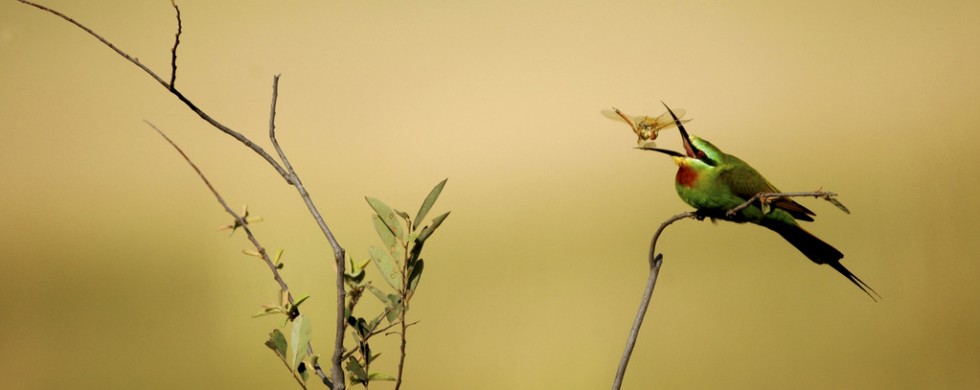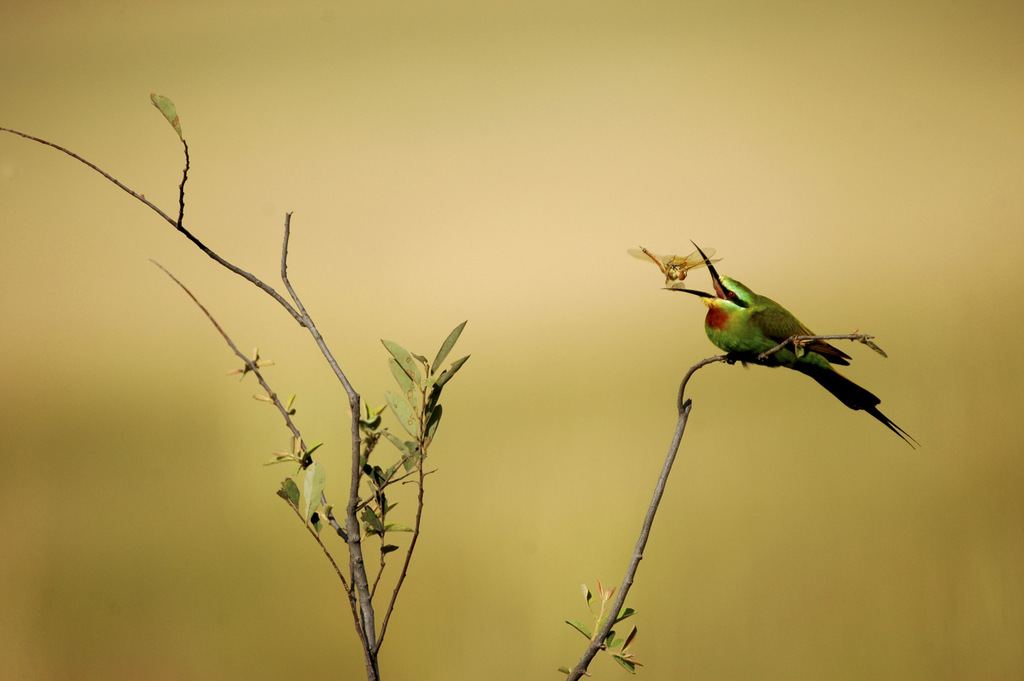
15
2008One (or three) for the Road – July 2008
Shot of the Month – July 2008
This story provides a little insight into some of the elements that are necessary in getting that “lucky” shot. This image was probably the second frame of a four-shot burst. While looking through the viewfinder I saw this behavior but I wasn’t sure if I managed to catch the action at just the right moment. Once finished shooting, I feverishly hit the review button on the back of my camera body and scrolled through the sequence of shots. As soon as the image appeared, even on the tiny 2-inch LCD screen, I knew that this might be the shot of the safari.
Once back home I was able to verify that that the shot was as good as I had hoped. Was this just a lucky shot? Well, some luck is almost always involved, but as they say, with hard work, you can create your own good luck.
How did this all happen?
Well, this is a photo of a Blue-cheeked Bee-eater (BCBE) in an area of the Kalahari Desert in Botswana. I had never seen a BCBE before this trip and I had tried for several days to get a decent shot with no success. While driving along a dirt path in an open field we spotted several BCBEs flying sorties and catching insects. Our guide told us that the birds were most likely trying to fatten up before continuing their migration. We accelerated so we could reach the point along the path that would bring us as close as possible to where the birds were flying—park rules do not allow us to go off the road so we had to hope that we could get close enough.
This is where knowledge of animal behavior comes in handy. I had seen many other types of bee-eaters in my day and I knew that when they are hunting they like to return to the same tree or shrub to eat their prey. BCBEs love to eat dragonflies and in the space of about five minutes, this bird had caught three! Early on I saw that he had perched on this shrub so while he was off hunting I set my camera up and waited for his return (hopefully). Knowing the behavior of the bird allowed me to set myself up properly and be prepared in advance for the next opportunity. From his previous “kill” I knew that he would whack the dragonfly a few times on the branch to make sure that it was dead before launching it into the air. Within a minute or two he was back with a dragonfly in his mouth.
Next, I had to make sure that I was using the right camera settings for this type of shot. For this scene I maximized the aperture—this does two key things. First, it allows for the fastest shutter speed possible to stop the action which I hoped we would see. Second, it creates a shallow range of focus — the bird would be in focus but anything in the background would be blurry — just what you want for a “portrait” like this. That great sea of yellow in the background is actually long yellow grass—the wide open aperture blurred that out and allowed the subject of the photo to pop out in contrast. I set the auto-focus to continuous mode — this setting is best for action scenes and it tells the camera to keep tracking the object and adjust the focus as necessary. Finally, the shutter was set to High-Speed Continuous — as long as I held the shutter release button down the camera would take photos. A high-speed burst of images was just what I needed to try and capture this split-second action.
Proper technique also played a big role in getting this shot. I was using a 300-800mm lens for this scene–this 22-inch, 12-pound beast magnifies the tiniest of minute vibrations–the slightest movement of the lens, of the camera, or the vehicle would create a blurred image. I used a bean bag on the roof of the vehicle to stabilize the lens, essentially using the truck as a large tripod.
Everyone in the vehicle was well versed (some would say threatened) on the importance of not moving, or even breathing heavily while I was shooting. I pre-composed the shot and pre-selected the focus point before the bird arrived. While shooting I braced my body against a seat, controlled my breathing, and gently squeezed the shutter release—all to ensure no movement of the camera.
And last, yes, a good dose of luck is always important. We were lucky to find the birds in hunting mode. We were lucky that the road came juuust close enough to allow us to get within range for a shot. The lighting was good and the backdrop for the shot was perfect.
This is one of my favorite photos and I have a 16”x24” version of it hanging on my wall. The image has an oriental feel with its minimalist design and from the hues and color palate of the scene.
Capturing the bee-eater just at this crucial moment, with the dragonfly in JUST the perfect position, in such a beautiful setting is truly a small miracle.
Lucky? Sure, but as you can see, serendipity can sometimes use a helping hand….:-)

